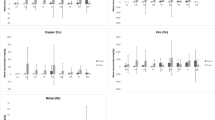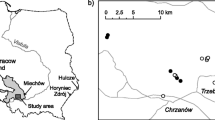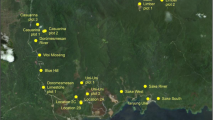Abstract
Antimony occurs locally at high concentrations in some mineralized soils. Very little is known about behavior of antimony in plants. In this study, we analyzed the soil and vegetation of two mining areas in Iran, Patyar, and Moghanlo. Total Sb concentrations in soil were 358–3482 mg/kg in Moghanlo and 284–886 mg/kg in Patyar. Corresponding Sb concentrations in plant shoots were 0.8–287 and 1.3–49 mg/kg, respectively. In both areas, foliar Sb concentrations increased with acid-extractable soil Sb, although the slope was about 2-fold steeper for Patyar than for Moghanlo. Regressing the foliar concentrations on water-soluble Sb yielded identical slopes for both areas, suggesting that the soluble fraction of Sb rather than total Sb is the direct determinant of foliar Sb accumulation. Both in Patyar and Moghanlo, only a minor part of the total variance of shoot Sb was explained by soluble Sb. The major part was explained by plant species, demonstrating that plant taxonomic identity is the most important determinant of foliar Sb accumulation capacity in both areas. The translocation factor (TF) was highly variable too, with species as the only significant variance component. Only four species were able to accumulate more than 100 mg/kg Sb in their leaves. Among these species, Achillea wilhelmsii and Matthiola farinosa were by far the best Sb accumulators, with, on average, 141 and 132 mg/kg Sb in their leaves. Of these two, only Matthiola farinosa consistently maintained TF values far above unity across the whole range of soluble Sb in Moghanlo.



Similar content being viewed by others
References
Ainsworth N, Cooke JA, Johnson MS (1991) Distribution of antimony in contaminated grassland: 1- Vegetation and soils. Environ Pollut 65:65–77
Ashley PM, Craw D, Graham BP, Chappell DA (2003) Environmental mobility of antimony around mesothermal stibnite deposits, New South Wales, Australia and southern New Zealand. J Geochem Explor 77:1–14
Baroni F, Boscagli A, Protano G, Riccobono F (2000) Antimony accumulation in Achillea ageratum, Plantago lanceolata and Silene vulgaris growing in an old Sbmining area. Environ Pollut 109:347–352
Bech J, Corrales I, Tume P, Barceló J, Duran P, Roca N, Poschenrieder C (2012) Accumulation of antimony and other potentially toxic elements in plants around a former antimony mine located in the Ribes Valley (Eastern Pyrenees). J Geochem Explor 113:100–105
Bowen HJM (1979) Environmental chemistry of the elements. Academic Press, London
Brooks RR (1972) Geobotany and biogeochemistry in mineral exploration. Harper & Row, New York
Casado M, Anawar HM, Garcia-Sanchez A, Santa Regina I (2007) Antimony and arsenic uptake by plants in an abandoned mining area. Commun Soil Sci Plant Anal 38:1255–1275
Crommentuijn T, Polder MD, van de Plasche EJ (1997) Maximum permissible concentrations and negligible concentrations of metals, taking background concentrations into account. RIVM Report No. 601 501 001. National Institute of Public Health and the Environment, Bilthoven
Cui Y, Zho Y, Zhai R, Chen D, Huang Y, Qiu Y, Liang J (2004) Transfer of metals from soil to vegetables in an area near a smelter in Nanning, China. Environ Int 30:785–791
Feng R, Wei C, Tu S, Ding Y, Wang R, Guo J (2013) The uptake and detoxification of antimony by plants: a review. Environ Exp Bot 96:28–34
Filella M, Belzile N, Chen YW (2002) Antimony in the environment: a review focused on natural waters: I. Occurrence. Earth Sci Rev 57:125–176
Filella M, Williams PA, Belzile N (2009) Antimony in the environment: knowns and unknowns. Environ Chem 6:95–105
Fowler BA, Goering PL (1991) Antimony. In: Merian E (ed) Metals and their compounds in the environment. VCH, Weinheim, pp 921–930
Gebel T, Christensen S, Dunkelberg H (1997) Comparative and environmental genotoxicity of antimony and arsenic. Anticancer Res 17:2603–2608
Gee GW, Bauder JW (1986) Particle-size analysis. In: Klute A (ed) Methods of soil analysis. Part 1. Physical and mineralogical methods. American Society Agronomy and Soil Sciences, Madison
Gerritse RG, Vriesema R, Dalenberg JW, de Roos HP (1982) Effect of sewage sludge on trace element mobility in soils. J Environ Qual 11:359–364
Ghaderian SM, Hemmat GR, Reeves RD, Baker AJM (2007) Accumulation of lead and zinc by plants colonizing a metal mining area in central Iran. J Appl Bot Food Qual 81:145–150
Hammel W, Debus R, Steubing L (2000) Mobility of antimony in soil and its availability to plants. Chemosphere 41:1791–1798
He M (2007) Distribution and phytoavailability of antimony at an antimony mining and smelting area, Hunan, China. Environ Geochem Health 29:209–219
Hozhina EI, Khramov AA, Gerasimov PA, Kumarkov AA (2001) Uptake of heavy metals, arsenic, and antimony by aquatic plants in the vicinity of ore mining and processing industries. J Geochem Explor 74:153–162
Kabata-Pendias A, Mukherjee AB (2007) Trace elements from soil to human. Springer–Verlag, Berlin
Lintschinger J, Michalke B, Schulte-Hostede S, Schramel P (1998) Studies on speciation of Sb in soil contaminated by industrial activity. Int J Environ Anal Chem 72:11–25
Murciego AM, Sánchez AG, González MAR, Gil EP, Gordillo CT, Fernández JC, Triguero TB (2007) Antimony distribution and mobility in topsoils and plants (Cytisus striatus, Cistus ladanifer, Dittrichia viscosa) from polluted Sb-mining areas in Extremadura (Spain). Environ Pollut 145:15–21
Nakamaru Y, Tagami K, Uchida S (2006) Antimony mobility in Japanese agricultural soils and the factors affecting antimony sorption behavior. Environ Pollut 141:321–326
Pratas J, Prasad MNV, Freitas H, Conde L (2005) Plants growing in abandoned mines of Portugal are useful for biogeochemical exploration of arsenic, antimony, tungsten and mine reclamation. J Geochem Explor 85:99–107
Qi C, Wu F, Deng Q, Liu G, Mo C, Liu B, Zhu J (2011) Distribution and accumulation of antimony in plants in the super-large Sb deposit areas, China. Microchem J 97:44–51
Reeves RD, Baker AJM (2000) Metal-accumulating plants. In: Raskin I, Ensley BD (eds) Phytoremediation of toxic metals: using plants to clean up the environment. Wiley, NY, pp 193–229
Ruiz E, Rodríguez L, Alonso-Azcárate J (2009) Effects of earthworms on metal uptake of heavy metals from polluted mine soils by different crop plants. Chemosphere 75:1035–1041
Schnorr TM, Steenland K, Thun MJ, Rinsky RA (1995) Mortality in a cohort of antimony smelter workers. Am J Ind Med 27:759–770
Shotyk W, Krachler M, Chen B (2005) Anthropogenic impacts on the biogeochemistry and cycling of antimony. In: Sigel A, Sigel H, Sigel R (eds) Metal ions in biological systems. volume 44: biogeochemistry, availability, and transport of metals in the environment. Marcell Dekker, New York, pp 171–203
Shtangeeva I, Steinnes E, Lierhagen S (2011) Uptake of different forms of antimony by wheat and rye seedlings. Environ Sci Pollut Res 19:502–509
Smichowski P (2007) Antimony in the environment as a global pollutant: a review on analytical methodologies for its determination in atmospheric aerosols. Talanta 75:517–568
Storer DA (1984) A simple high sample volume ashing procedure for determining soil organic matter. Commun Soil Sci Plant Anal 15:759–772
Tan KH (1996) Soil Sampling, preparation and analysis. Marcel Dekker, New York
Tschan M, Robinson BH, Schulin R (2009) Antimony in the soil-plant system - a review. Environ Chem 6:106–115
Van der Ent A, Baker JM, Reeves RD, Pollard AJ, Schat H (2013) Hyperaccumulators of metal and metalloid trace elements: facts and fiction. Plant Soil 362:319–334
Wilson SC, Lockwood PV, Ashley PM, Tighe M (2010) The chemistry and behavior of antimony in the soil environment with comparisons to arsenic: a critical review. Environ Pollut 158:1169–1181
Acknowledgments
We would like to thank the Graduate School of University of Isfahan for providing research facilities for this study. We also thank from Plant Stress Center of Excellence (University of Isfahan) for its support of this study.
Conflict of interest
The authors declare that they have no conflict of interest, also confirm that the manuscript complies to the Ethical Rules applicable for this journal.
Author information
Authors and Affiliations
Corresponding author
Additional information
Responsible editor: Elena Maestri
Rights and permissions
About this article
Cite this article
Jamali Hajiani, N., Ghaderian, S.M., Karimi, N. et al. A comparative study of antimony accumulation in plants growing in two mining areas in Iran, Moghanlo, and Patyar. Environ Sci Pollut Res 22, 16542–16553 (2015). https://doi.org/10.1007/s11356-015-4852-5
Received:
Accepted:
Published:
Issue Date:
DOI: https://doi.org/10.1007/s11356-015-4852-5




